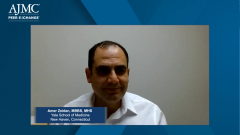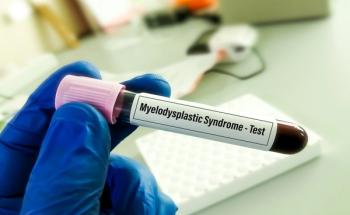
Interchangeability Between Oral and IV Agents in HR-MDS
Experts reflect on interchangeability between oral and intravenous therapy in patients with higher-risk myelodysplastic syndromes.
Episodes in this series

Transcript:
Bruce Feinberg, DO: Amer, I want to ask you something, because it’s specific. We talked a little about the advent of telemedicine. It’s a routine practice that was brought about by the pandemic. Now we have our next COVID-19 variant. We don’t quite know what Omicron is going to mean, but it does raise questions. What are your thoughts about interchangeability in regard to patients who are on HMAs [hypomethylating agents] and getting infused in the infusion center, and wholesale moving them to the oral agent if something like that were to happen?
Amer Zeidan, MBBS, MHS: This was quite an interesting phenomenon, because the oral decitabine was approved during the pandemic when there was already a lot of hesitancy about coming to any health care setting. Everybody was afraid to come; we were telling the patients not to come. At one point, we were in a situation where we were asking them to go to their local doctors. Luckily, a lot of this has gone away, but during that period, there were many patients who were completely transfusion-independent with complete responses, and they were just coming to get their injection, so having that option was very good. This continues to be the case now, that you can minimize their visits.
At one point, there also was a national shortage of azacitidine in many places and people had to switch. Even if they didn’t want to switch, they had to switch to either IV [intravenous] or oral decitabine. This has in some ways increased the exposure of the use of the oral drug to some physicians. But in my hands, I see very similar responses and a very similar adverse event profile. It’s very tolerable, but you still have to monitor the patient. You have to monitor and manage the cytopenias. In my view, you can switch patients from any injectable HMA to an oral HMA, and that might be a good use because the patient is generally transfusion-independent at that point, and this is why they’re still getting the HMA.
Bruce Feinberg, DO: Ryan, interchangeability has a very specific meaning to a pharmacist. We don’t have specific criteria established, but do you think this is an opportunity to get increased exposure to the oral agent? Do you think status quo bias is going to limit the uptake of a new agent when you’ve had a disease that’s difficult to manage, where you have your tried-and-true solution that you’re comfortable with and you know how to manage? Do you think there’s that perceived interchangeability if we get into another situation with Omicron? How do you go about that, since you’re going to be looked to as the expert around that? How would you look to that being managed?
Ryan Haumschild, PharmD, MS, MBA: First, I’d say we never let a good crisis go to waste. With the pandemic, we forced the use of telemedicine and for CMS [Centers for Medicare & Medicaid Services] to reimburse there. We’ve also learned how to utilize new therapies that are more convenient for the patients. If we start to see this spike with the new variant and we feel like we can’t bring patients into our centers, there’s a pallet there of, how do we look at oral agents? Even if there aren’t data, because interchangeability is an FDA approval, we just got our first biosimilar with that, hallelujah. But we’ve been using interchangeability differently through our P&T [pharmacy and therapeutics] committee. Amer’s probably used to this, where pharmacy brings forward a policy and says, “We can approve interchangeability for these specific patients with these criteria, and therefore we can do it upon dispensation.”
Bruce Feinberg, DO: Wait, you’re doing this as an independent P&T institutionally, irrespective of what the FDA makes the determination to be?
Ryan Haumschild, PharmD, MS, MBA: You’re exactly correct. We can make interchangeability based on policy and procedure at our institution. I’ll give you an example with biosimilars. There was technically no biosimilar interchangeable. That means you had to call the provider and say, “I’d like to exchange this reference medication for the biosimilar.” We got buy-in from all of our providers, brought it to P&T, and got it signed off that pharmacy is OK to interchange the medications. They have our approval through policy. That’s a way to get that interchange done a lot more quickly, because it takes a long time for someone to prove interchangeability as defined by the FDA. When you see these crises come up, I think you’ll see the physicians and providers start to put a lot of effort into that policy, and then they’ll feel a lot more comfortable based on those criteria of pharmacy making those changes based on patient-specific criteria that align with the goals and mission of the cancer center.
Bruce Feinberg, DO: Amer, do you see things similarly happening at Yale University?
Amer Zeidan, MBBS, MHS: Yes, especially during the pandemic and azacitidine shortage, that helped a lot of people make that type of decision that we were already somewhat comfortable with clinically. But those certainly help.
Bruce Feinberg, DO: Tracey, from the patient advocacy perspective, how do you as an organization manage that? Because you’re supposed to be the trusted resource; none of us can be. We’re all in our institutions. We have our own biases. But you’re not, you’re the trusted source. Do you have a panel of advisers? Do you have some means by which you can try to answer these questions for patients who are in a crisis moment trying to figure out how they’re going to manage?
Tracey Iraca: Absolutely. We depend on these guys. We have a board of directors made up of physicians who are experts in the field of MDS [myelodysplastic syndromes]. We have a medical and scientific advisory board and a nurse leadership board. If we get questions, they always go back out to the professionals to make sure we’re keeping our patients safe. For the pandemic in general, patients with MDS were already used to having a compromised immune system, so they were already careful and cautious, but this amped it up significantly.
These alternatives to having to go in and expose themselves to COVID-19 were something that we immediately turned to our doctors and asked, “When is it safe? When is it safe for our patients to go back into live events? When can they have support groups again?” That time hasn’t come yet, but those same questions apply to, “What are the alternatives where I don’t have to go into the treatment center and risk exposure if possible?” That’s something we always turn to the experts for. We don’t make that determination, but thankfully they’re always there for us and able to give us quick answers.
Transcript edited for clarity.
Newsletter
Stay ahead of policy, cost, and value—subscribe to AJMC for expert insights at the intersection of clinical care and health economics.










































